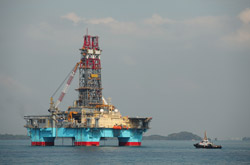Measuring up to water's might
The Marie Curie International Outgoing Fellowship (IOF) 'Fluid-structure interactions in offshore engineering' (Offshore FSI) project studied the impact of water slamming on marine structures. The objective was to produce data regarding the impact of different wave heights, length and steepness, and the geometry and immersion of a structure on its deformation. The focus applied mainly to floating production systems, surface vessels and offshore energy generation devices. The fellow designed a slingshot impact testing system for simulating water impact on different types of structures. The machine produced good experimental data and offers a new facility for future investigations. Another project objective was to study flow-induced or vortex-induced vibrations of flexible structures. These are extremely common in marine engineering and offshore facilities, yet concerns remain about the effects of surface waves, motions on the structural response and developed wakes on downstream structures. Project efforts resulted in a large amount of data being collected with the help of a free surface tunnel, commonly used for hydrodynamic research. The Offshore FSI fellow used a three-dimensional imaging technique known as defocusing digital particle image velocimetry to examine how flexible bodies deform over time. He also learned how to apply this technique in other innovative experiments and participated in the measuring of the dynamic response of marine propellers under different operating conditions. This marked a first for the level of precision achieved and the optical measurement of the motion of a propeller's blades in normal operation. Outcomes stand to significantly impact future propeller design and validation. The project closing involved completing analyses of the work undertaken, publication of papers with results achieved and creation of a new research group. The fellow also applied for new sources of funding so as to implement project outcomes in the design and construction of new facilities and instrumentation for future research. The knowledge acquired has the potential to improve future engineering applications and is relevant to surface vessels, floating production systems and new offshore energy generation devices.







